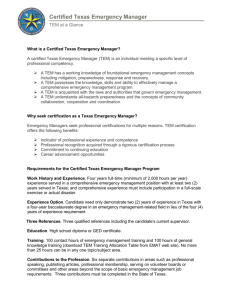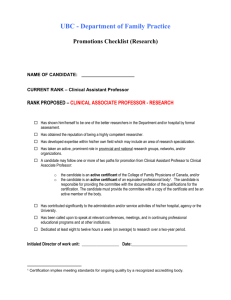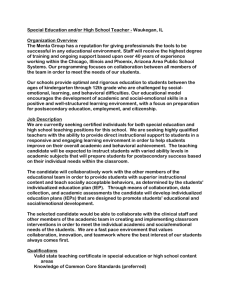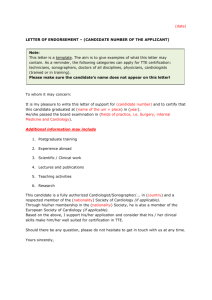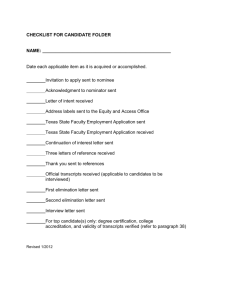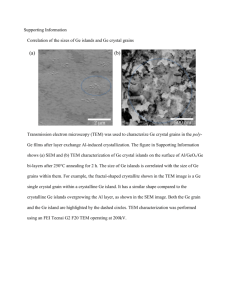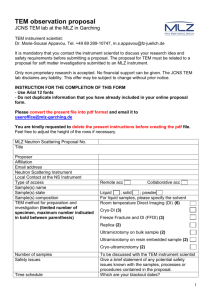TEM CERTIFICATION SUBMISSION CHECKLIST
advertisement
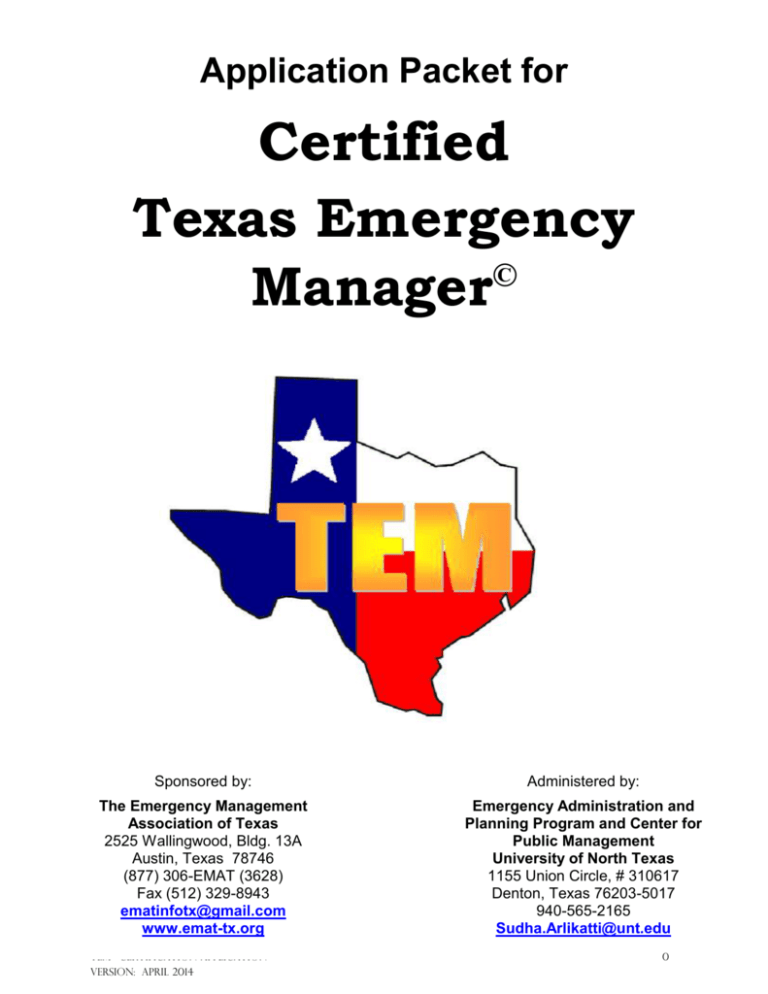
Application Packet for Certified Texas Emergency Manager© Sponsored by: Administered by: The Emergency Management Association of Texas 2525 Wallingwood, Bldg. 13A Austin, Texas 78746 (877) 306-EMAT (3628) Fax (512) 329-8943 ematinfotx@gmail.com EMATinfo@aol.com www.emat-tx.org Emergency Administration and Planning Program and Center for Public Management University of North Texas 1155 Union Circle, # 310617 Denton, Texas 76203-5017 940-565-2165 Sudha.Arlikatti@unt.edu TEM© Certification Application VERSION: April 2014 0 The Emergency Management Association of Texas 2525 Wallingwood, Bldg. 13A Austin, Texas 78746 (877) 306-EMAT (3628) ● Fax (512) 329-8943 e-mail: ematinfotx@gmail.com www.emat-tx.org Preface BOARD OF DIRECTORS OFFICERS President Jeb B. Lacey, CEM Victoria County VICE PRESIDENT Jamie Galloway, TEM City of Nassau Bay SECRETARY Karen E. Adkins, CEM City of McKinney TREASURER Shelly K. Butts Madison County SERGEANT-AT-ARMS Kevin Starbuck, CEM, CPM Amarillo/Potter/Randall DIRECTORS Jeff Braun, CEM George Garrett Dee Harrison, CEM, TEM Sean Hughes, CEM, TEM Cindy Mohat, CEM, TEM Patrice Reisen Patrick Repman Courtney Smith-Ring, CEM Billy Ted Smith Wendy Smith Jeff Suggs R.J. Thomas Brenda Vermillion EXECUTIVE DIRECTOR James E. Coles, CAE Austin EXECUTIVE ASSISTANT Nancy J. Davis This document describes the requirements and standards of the Texas Emergency Manager (TEM©) certification program and serves as the basis for your application packet. The Emergency Management Association of Texas (EMAT) sponsors this certification program and the Emergency Administration and Planning Program and Center for Public Management (EADP), University of North Texas administers it. You do not have to be a member of either organization in order to be certified. EMAT and EADP are both dedicated to promoting the goals of saving lives and protecting property through application of the four phases of emergency management. One method shown to increase professionalism and recognize the individual who possesses the knowledge, skills, abilities and experience to manage effectively a comprehensive emergency management program is through a rigorous certification program. The TEM© is just such a program. EMAT reviewed the certification programs of numerous states and associations and decided to base the TEM© on the International Association of Emergency Manager’s Certified Emergency Manager (CEM®) program. The board chose the CEM® program for three reasons. The first reason is that it is a comprehensive evaluation of an emergency manager’s knowledge, skills and abilities through an internationally recognized certification program. The second reason is that the CEM® program was developed with assistance and input from practicing emergency managers throughout the United States, academia, and FEMA. The third reason is that the State of Texas considers an individual designated as a CEM® who has completed the Basic Emergency Management Workshop (G-610) to meet the training requirements at the Advanced Preparedness Level (TDEM 100, June 2011, page 2-5). The TEM© certification program modifies the CEM® requirements by adding Texas-unique requirements, such as experience and exercise/disaster event participation. A second difference is that the TEM© does not require a college degree for certification. EMAT recognizes that many emergency managers never had the opportunity to attend college, yet possess the knowledge, skills and abilities to manage effectively a comprehensive emergency management program. The TEM© addresses that situation. As the experienced emergency managers retire and the new crop of college-educated emergency managers take over, this requirement will change. Certification is an indicator of experience, hard work, continuing education, dedication to integrity, and creativity. It is also an assurance that the individual has passed at least a minimum screening of competence. Obtaining certification as a TEM© proves that you can effectively accomplish the goals and objectives of comprehensive emergency management in Texas. TEM© Certification Application VERSION: April 2014 1 EMAT CODE OF PROFESSIONAL CONDUCT Introduction The Emergency Management Association of Texas (EMAT) is a nonprofit organization dedicated to promoting and advancing the professionalism of emergency management and disaster preparedness in Texas. EMAT sponsors the Texas Emergency Manager (TEM©) certification program to document and strengthen the professionalism of Texas emergency managers. The Purpose of the Code The Code of Professional Conduct must be embraced and upheld by all individuals who are awarded the TEM© certification. The candidate’s promise to uphold the Code signifies the assumption that the certified Texas Emergency Manager will act prudently and responsibly beyond the requirements of law and codes. Enforcement of the Code The EMAT Executive Board enforces the Code by receiving and investigating all complaints of violations and by taking the necessary action, as appropriate, including but not limited to the revocation of an individual's TEM© certification. The Code of Professional Conduct The Code embodies the TEM© certification program philosophy and objectives. Each TEM© promises to: Accept and dutifully carry out all associated responsibilities incumbent upon his or her position of public trust; Serve the public with integrity and honesty in all matters; Promote public awareness toward and understanding of emergency preparedness and public protection; Foster excellence in emergency management by keeping abreast of pertinent issues; Enhance individual performance through continuing education and applied technology; Avoid conflict of interests resulting in personal gain or advantage or the perception thereof; Conserve and protect resources through effective use of funds, accurate assessment of potential hazards, and timely decision making; Maintain confidentiality of privileged information; and Share his or her work product with other TEMs© in order to expand the collective capability of the profession. TEM© Certification Application VERSION: April 2014 2 TEM© APPLICATION COVER SHEET WITH CODE OF CONDUCT PLEDGE REMINDER: Type all Responses! 1. Name: 2. Jurisdiction: 3. Current Position/Title: 4. Years in Current Position: 5. Years in Emergency Management: 6. I understand that certification is subject to EMAT Executive Board approval, and if granted, is current for a five-year period. I will execute the necessary documents and supply any additional information as determined by EMAT. I further understand and, by my signature, I subscribe to the EMAT Code of Professional Conduct with the knowledge that any false statement or misrepresentation I make in the course of these proceedings may result in the revocation of this application and the issuance of a complaint of violation. Candidate's Signature: TEM© Certification Application VERSION: April 2014 __________________ Date: __________ 3 TEM© CERTIFICATION SUBMISSION CHECKLIST Use this checklist to ensure your submission is complete. A. Completed Application Cover Sheet with Code of Conduct Pledge: Requires Candidate’s Signature. B. Completed Credentials Packet: Work History Requires a full-scale exercise or actual disaster experience in Texas and copies of position descriptions or supervisor statements. References Requires names and current contact information. Education Requires a copy of diploma or GED certificate. Training Requires appropriate documentation. Contributions to the Profession Requires documentation or contact information where requested. Three must be completed in Texas. C. Completed Management Essay or Passing Score on Emergency Management Exam: Requires Essay Response to one Scenario, OR Requires signed “independent work” statement. ____ Passing Score on Emergency Management Exam. Application will be held until exam score is received. Miscellaneous: Type All Materials (unless otherwise specified, such as a signature.) Fees Payment Enclosed – Pay to the Order of EMAT. Check or money order accepted -- DO NOT SEND CASH. Application packet and payment mailed to EADP, University of North Texas. Please Print Name: ___________________________________________________________________ TEM© Certification Application VERSION: April 2014 4 TEM© CREDENTIALS PACKET This portion of the certification process is designed to: I. Verify the candidate's work-history and experience. II. Review references submitted by the candidate. III. Verify the candidate's participation in and completion of educational requirements. IV. Verify the candidate's participation in and completion of training requirements. V. Document support of and contributions to the emergency management profession. Submit all credentials application information on the appropriate forms, if directed. Submit all requested components in one complete package. Duplicate the forms as often as necessary. All required signatures must be original (preferably in blue ink). Submit only enough documentation to insure a favorable review. Certification Reviewers will consider brevity favorably. You may want to submit an extra professional contribution in case one is found incomplete during the review process. In order to enhance your document review, submit the most current information possible. Do not document your entire history in emergency management or in a responder activity. TEM© Certification Application VERSION: April 2014 5 I. WORK–HISTORY AND EXPERIENCE To satisfy this requirement a candidate must demonstrate: Four years full-time equivalent (2,000 hours per year or more) experience in a comprehensive emergency management position with at least two years served in Texas; and Meaningful role in the development and/or participation in a full scale exercise in Texas, OR Actual disaster and recovery management experience in Texas that necessitated activation of local emergency plans. That is, candidates complete IA. below, and either IB. or IC. Candidate must submit a copy of his/her CURRENT position description. If credit for the disaster/emergency management experience is from a PREVIOUS job or role, submit a copy of the position description (s) with the dates of service. If a current position does not exist, or if a copy needed from a previous job is not available, so state in a brief letter signed by the candidate, attached to a signed letter/statement from the current (or past) supervisor that states that (1) a position description does not exist, has been changed, or is unavailable, and (2) outlines (a) the disaster/emergency management functions performed by the candidate, (b) the dates of this service, and (c) the approximate amount of time spent in disaster/emergency management duties. Time spent on volunteer/internship duties may also be counted, but applicants must provide documentation of the total time devoted to disaster/emergency management duties. Candidates may utilize the same position for a period of four years or any combination of positions. Completing the enclosed appropriate form(s) will satisfy verification of your exercise or actual disaster and recovery management experience. EXPERIENCE OPTION -- A candidate need only demonstrate two (2) years’ experience in Texas with a baccalaureate degree in an emergency management-related field in lieu of the 4 years of experience requirement. IA. WORK–HISTORY Job Title: Period Covered Job Title: Period Covered Job Title: Period Covered TEM© Certification Application VERSION: April 2014 6 IB. EXPERIENCE -- NOTE: Complete IA. and either IB. or IC. Exercise Participation in Texas Date of Exercise: Describe the Exercise (be specific): Describe Your Role (be specific): Describe What You Learned from Your Participation in this Exercise: TEM© Certification Application VERSION: April 2014 7 IC. EXPERIENCE -- NOTE: Complete IA. and either IB. OR IC. Actual Occurrence/Disaster and Recovery Management Participation in Texas, If Applicable Describe Activity (be specific): Describe Your Role (be specific): Describe the Mitigation Activities Undertaken as a Result of Lessons Learned from this Activity: TEM© Certification Application VERSION: April 2014 8 II. CANDIDATE REFERENCE REQUIREMENT Each candidate must submit the names of three references, and information on their reference sources, as requested below. NOTE: Let your reference sources know they are being so listed, because the Commission will make verification calls to check the information provided. A. Reference sources that qualify are: Current supervisor (Mandatory) A past supervisor (within the last 5 years) Local, state or federal government officials or department heads (including RLOs) Emergency service organization officials (e.g., public, private, military, tribal, etc.) Local, regional or national emergency management association officials B. Reference sources that do not qualify are: A subordinate or peer A former student Friends, relatives or neighbors 1. REFERENCE NAME/TITLE ORGANIZATION ADDRESS CITY/ST/ZIP PHONE/FAX/EMAIL 2. REFERENCE NAME/TITLE ORGANIZATION ADDRESS CITY/ST/ZIP PHONE/FAX/EMAIL 3. REFERENCE NAME/TITLE ORGANIZATION ADDRESS CITY/ST/ZIP PHONE/FAX/EMAIL TEM© Certification Application VERSION: April 2014 9 III. EDUCATION REQUIREMENT High School/City, State Year Graduated OR GED/City, State Year Completed REMINDER: Verification must be attached in the form of a diploma or other acceptable documentation, such as a letter from the school. A college degree is an acceptable alternative to the diploma or GED certificate. TEM© Certification Application VERSION: April 2014 10 IV. TRAINING HOURS Each candidate must demonstrate successful completion of 100 classroom hours of emergency management training and 100 classroom hours of general management training with a maximum of 25 hours in any one topic/subject area. General Management courses are those that contribute to or complement emergency management tasks and are knowledge that any manager would find useful in supporting his or her job tasks. Examples of training courses, hours credited and area allocations are in a separate document. Candidates must complete the enclosed form for each training program submitted for qualification. While there is no time restriction on training submissions, candidates should submit their most current training certificates or transcript from the training section of TDEM. A candidate should not reflect his/her entire training history, but simply provide ample training listings in the event the review panel might find a submission questionable. A. Workshop, Seminar and/or Course Source Requirements Sources of Training that may qualify for submission are: Federal Agencies (FEMA, EPA, DOT, DOE, etc.) State and Local Agencies Accredited Four-Year Institutions Accredited Two-Year Institutions Vendor-Sponsored Courses Military Programs Private Organizations Professional Societies/Organizations/Associations Other REMINDER: Verification must be attached in the form of a certificate or transcript reflecting the course, a class roster with your name on it, a receipt, or other acceptable documentation. Verification must reflect the number of classroom hours earned. If hours are not included on the certificate and it is a FEMA course, you will receive only the minimum recommended hours. NonFEMA courses will receive up to six hours credit per day unless additional hours can be independently verified (course syllabus, agenda, course catalog, etc.). NOTE: Some institutions provide C.E.U. equivalency information; one Continuing Education Unit (C.E.U.) = 10 Classroom Hours. TEM© Certification Application VERSION: April 2014 11 B. Course/Program Content Workshop, Seminar and/or Course SAMPLE subject matter acceptable for submission: Emergency Management Civil Defense Systems, Programs and Policies Criminal Justice/Law Enforcement Disaster Preparedness Emergency Management Foundations (Four Phases of Emergency Management) Emergency Medical Training Emergency Operations Centers Emergency Planning and Crisis Management Fire Technology Hazard Analysis and Capabilities Assessment Hazardous Material Management and Hazards Assessment Incident Command Medical Technology Physical Sciences Public Information Radiological Monitoring, Detecting, etc. Safeguards and Security Technology, Equipment and Information Systems Related to Emergency Management Training and Instruction Urban Search and Rescue General Management Behavioral and Social Sciences Communication: Written and Oral Decision-making and Problem-solving Executive and Management Development Financial Management and Budgeting Grantsmanship (Development, Evaluation and Reporting) Human Resource/Personnel Management Leadership, Influence and Ethics Marketing, Public Relations and Media Management Strategic and Tactical Planning Technology, Equipment and Information Systems Volunteer Resources TEM© Certification Application VERSION: April 2014 12 SUMMARY OF TRAINING HOURS IN EMERGENCY MANAGEMENT FORM Course/Seminar/Workshop Title Classroom Hours TOTAL EMERGENCY MANAGEMENT TRAINING HOURS: • At least 100 hours of training are required in emergency management. You need not complete each line above; complete only enough to ensure you meet the requirement. • No more than 25 hours of training can be in any one subject/topic area. Therefore, you must have at least four different listings in emergency management training. Candidates should list actual classroom hours even though they may total over 25 for a particular course. TEM© Certification Application VERSION: April 2014 13 TRAINING SUBMISSIONS FORM*........................................................................... Emergency Management A) Training Title and Number (number where applicable): B) Training Source: C) Training Date: D) Training Length/By Hours: E) Training Content Summary: F) Describe practical applications of training opportunities as you have utilized those learning principles: * Candidate should duplicate this form as often as necessary to fulfill the 100 classroom hours training required in Emergency Management. TEM© Certification Application VERSION: April 2014 14 TRAINING SUBMISSIONS FORM*........................................................................... Emergency Management A) Training Title and Number (number where applicable): B) Training Source: C) Training Date: D) Training Length/By Hours: E) Training Content Summary: F) Describe practical applications of training opportunities as you have utilized those learning principles: * Candidate should duplicate this form as often as necessary to fulfill the 100 classroom hours training required in Emergency Management. TEM© Certification Application VERSION: April 2014 15 TRAINING SUBMISSIONS FORM*........................................................................... Emergency Management A) Training Title and Number (number where applicable): B) Training Source: C) Training Date: D) Training Length/By Hours: E) Training Content Summary: F) Describe practical applications of training opportunities as you have utilized those learning principles: * Candidate should duplicate this form as often as necessary to fulfill the 100 classroom hours training required in Emergency Management. TRAINING SUBMISSIONS FORM*........................................................................... Emergency Management TEM© Certification Application VERSION: April 2014 16 A) Training Title and Number (number where applicable): B) Training Source: C) Training Date: D) Training Length/By Hours: E) Training Content Summary: F) Describe practical applications of training opportunities as you have utilized those learning principles: * Candidate should duplicate this form as often as necessary to fulfill the 100 classroom hours training required in Emergency Management. TEM© Certification Application VERSION: April 2014 17 SUMMARY OF TRAINING HOURS IN GENERAL MANAGEMENT FORM Course/Seminar/Workshop Title Classroom Hours TOTAL GENERAL MANAGEMENT TRAINING HOURS: • At least 100 hours of training are required in general management. You need not complete each line above; complete only enough to ensure you meet the requirement. • No more than 25 hours of training can be in any one subject/topic area. Therefore, you must have at least four different listings in general management training. Candidates should list actual classroom hours even though they may total over 25 for a particular course. TEM© Certification Application VERSION: April 2014 18 TRAINING SUBMISSIONS FORM*..................................................................................General Management A) Training Title and Number (number where applicable): B) Training Source: C) Training Date: D) Training Length/By Hours: E) Training Content Summary: F) Describe practical applications of training opportunities as you have utilized those learning principles: * Candidate should duplicate this form as often as necessary to fulfill the 100 classroom hours training required in General Management. TEM© Certification Application VERSION: April 2014 19 TRAINING SUBMISSIONS FORM*..................................................................................General Management A) Training Title and Number (number where applicable): B) Training Source: C) Training Date: D) Training Length/By Hours: E) Training Content Summary: F) Describe practical applications of training opportunities as you have utilized those learning principles: * Candidate should duplicate this form as often as necessary to fulfill the 100 classroom hours training required in General Management. TEM© Certification Application VERSION: April 2014 20 TRAINING SUBMISSIONS FORM*..................................................................................General Management A) Training Title and Number (number where applicable): B) Training Source: C) Training Date: D) Training Length/By Hours: E) Training Content Summary: F) Describe practical applications of training opportunities as you have utilized those learning principles: * Candidate should duplicate this form as often as necessary to fulfill the 100 classroom hours training required in General Management. TEM© Certification Application VERSION: April 2014 21 TRAINING SUBMISSIONS FORM*..................................................................................General Management A) Training Title and Number (number where applicable): B) Training Source: C) Training Date: D) Training Length/By Hours: E) Training Content Summary: F) Describe practical applications of training opportunities as you have utilized those learning principles: * Candidate should duplicate this form as often as necessary to fulfill the 100 classroom hours training required in General Management. V. PROFESSIONAL CONTRIBUTIONS TO AND SUPPORT OF THE FIELD OF EMERGENCY MANAGEMENT TEM© Certification Application VERSION: April 2014 22 The concept of professionalism is ultimately defined as one's contributions to the profession. Candidates can list any and all activities giving special consideration to the most recent current activities. While many of the categories do not require specific verification documenting activity, contact information is solicited and will be checked by the Certification Commission. The following activities qualify for submission. A valid and verifiable submission in at least six (6) categories, with three (3) completed in Texas, is necessary to meet this requirement. A. Active membership in an emergency management-related professional organization for at least three years. These professional organizations include, but are not limited to the Emergency Management Association of Texas, Capital Area Emergency Management Association, Coastal Bend Emergency Management Association, South Central Emergency Management Association, American Public Works Association, American Society for Public Administration, International Association of Emergency Managers, International Association of Chiefs of Police, International Association of Fire Chiefs, International City Management Association, National Emergency Management Association, and National Fire Protection Association. B. Attend a state, regional or national educational session meeting or emergency management-related conference. C. Serve as an active member on a Board, a Committee, a task force, or a special project for a professional, emergency management or a jurisdictional organization. D. Serve for at least one term as an Officer or in a leadership position on a Board, a Committee, a task force, or a special project for a professional, emergency management or a jurisdictional organization. E. Complete a special assignment or project for a jurisdictional or governmental committee or task force addressing emergency management issues. An example would be a special assignment or project for the county, LEPC, TDEM, FEMA, or EMI. The resulting product or decisions must make a significant contribution to or impact on the emergency management profession. F. Develop and participate in an educational or informational speaking engagement on an emergency management issue at a professional conference or public forum (including conferences, workshops, radio, television, educational video, etc.). G. Complete a teaching or instructing commitment on an emergency management-related topic for a minimum of three actual platform hours H. Serve as a Developer, Evaluator or Controller for a full-scale, functional, or a tabletop exercise or complete a disaster assignment outside the candidate’s jurisdiction. Demonstrate a significant role in the exercise or assignment and describe the lessons learned through participation. I. Write and have published (in print or on the Internet) an emergency management article, research project, brochure, or instructional pamphlet. TEM© Certification Application VERSION: April 2014 23 J. Develop and distribute a completed audio, video, audio-visual or computer software project directly related to emergency management. K. Receive an award or special recognition in the field of emergency management by an outside agency, organization or association. L. Complete a significant role as a full partner in the development or extensive revision of a course in emergency management offered at the state, national, or international level. M. Testify before a legislative body or contact an elected representative (the candidate must receive a written reply from the contact; an e-mail response is OK), at the national or state level, on any emergency management-related issue. N. Other contributions must be approved in advance by EMAT Executive Board. Examples include participation in TEM© Field Test, participation in invitation-only conferences and workshops, or service on EMI Board of Visitors. NOTE: Submit multiple examples where possible. Submit all information on the appropriate form. Duplicate forms for multiple submissions and utilize additional pages as necessary. Since this segment reflects contributions of and support to the field of emergency management, these submissions reflect activities over and above basic job performance. TEM© Certification Application VERSION: April 2014 24 V. CANDIDATE PROFESSIONAL CONTRIBUTIONS TO AND SUPPORT OF THE FIELD OF EMERGENCY MANAGEMENT A. Professional Membership – Maintain an active membership in an emergency management-related professional organization for at least three years. These professional organizations include, but are not limited to the Emergency Management Association of Texas, Capital Area Emergency Management Association, Coastal Bend Emergency Management Association, South Central Emergency Management Association, American Public Works Association, American Society for Public Administration, International Association of Emergency Managers, International Association of Chiefs of Police, International Association of Fire Chiefs, International City Management Association, National Emergency Management Association, and National Fire Protection Association. To satisfy this requirement, a candidate must provide contact information for the professional organization. A candidate may submit more than one organization for a given year. Name of Organization: Contact Phone Number/Name: (list name and phone # of authorized Association agent.) Membership Year(s): Name of Organization: Contact Phone Number/Name: (list name and phone # of authorized Association agent.) Membership Year(s): TEM© Certification Application VERSION: April 2014 25 V. CANDIDATE PROFESSIONAL CONTRIBUTIONS TO AND SUPPORT OF THE FIELD OF EMERGENCY MANAGEMENT B. Professional Development -- Attend a regional, state, or national emergency management-related educational session meeting or conference. To satisfy this requirement, a candidate must demonstrate attendance (e.g. badge, roster, etc.) For each meeting attended, the candidate must complete the required information; utilize as many forms as required. Name and Date of Meeting: Session(s) Attended: Name and Date of Meeting: Session(s) Attended: TEM© Certification Application VERSION: April 2014 26 V. CANDIDATE PROFESSIONAL CONTRIBUTIONS TO AND SUPPORT OF THE FIELD OF EMERGENCY MANAGEMENT C. Service Role -- Serve for at least one term as an active member on a board, a committee, a task force, or a special project for a professional, emergency management, or a jurisdictional organization. To satisfy this requirement, a candidate may utilize one single service role or any combination of organizations. Name of Organization: Description of Role: Time Frame/Length of Service: Name of Organization: Description of Role: Time Frame/Length of Service: TEM© Certification Application VERSION: April 2014 27 V. CANDIDATE PROFESSIONAL CONTRIBUTIONS TO AND SUPPORT OF THE FIELD OF EMERGENCY MANAGEMENT D. Officer or Leadership Role – Serve for at least one term as an officer or in a leadership position on a board, a committee, a task force, or a special project for a professional, emergency management or a jurisdictional organization. To satisfy this requirement, a candidate must demonstrate an officer or board leadership role, utilizing one single leadership role or any combination of organizations. Name of Organization: Description of Role: Time Frame/Length of Service: Name of Organization: Description of Role: Time Frame/Length of Service: TEM© Certification Application VERSION: April 2014 28 V. CANDIDATE PROFESSIONAL CONTRIBUTIONS TO AND SUPPORT OF THE FIELD OF EMERGENCY MANAGEMENT E. Special Assignment – Complete a special assignment or project for a jurisdictional or governmental committee or task force addressing emergency management issues. An example would be a special assignment or project for the county, LEPC, TDEM, FEMA, or EMI. The resulting product or decisions must make a significant contribution to or impact on the emergency management profession. To satisfy this requirement, a candidate must describe special assignment service on a jurisdictional or governmental committee or task force addressing the emergency management issue. The candidate must demonstrate that the resulting product or decisions make a significant contribution or impact. Committee/Task Force Title: ______________________________________________________________________________ Sponsoring Organization (be specific): ______________________________________________________________________________ Individual who can verify service: ______________________________________________________________________________ (please provide contact name and telephone number) Description of Charge/Assignment: ______________________________________________________________________________ ______________________________________________________________________________ Description of Product/Contribution to Field: _______________________________________________________________________________ _______________________________________________________________________________ _______________________________________________________________________________ TEM© Certification Application VERSION: April 2014 29 V. CANDIDATE PROFESSIONAL CONTRIBUTIONS TO AND SUPPORT OF THE FIELD OF EMERGENCY MANAGEMENT F. Public Speaking — Develop and participate in an educational or informational speaking engagement on an emergency management issue at a professional conference or public forum (including conferences, workshops, radio, television, educational video, etc.). Description and Length of Engagement: Sponsoring Organization: Individual who can verify service: (please provide contact name and telephone number.) Location and Date of Activity: Description and Length of Engagement: Sponsoring Organization: Individual who can verify: (please provide contact name and telephone number.) Location and Date of Activity: TEM© Certification Application VERSION: April 2014 30 V. CANDIDATE PROFESSIONAL CONTRIBUTIONS TO AND SUPPORT OF THE FIELD OF EMERGENCY MANAGEMENT G. Teaching or Instructing — Complete a teaching or instructing commitment on an emergency management-related topic for a minimum of three actual platform hours. Description and Length of Engagement: Sponsoring Organization: Individual who can verify service: (please provide contact name and telephone number.) Location and Date of Activity: Description and Length of Engagement: Sponsoring Organization: Individual who can verify: (please provide contact name and telephone number.) Location and Date of Activity: TEM© Certification Application VERSION: April 2014 31 V. CANDIDATE PROFESSIONAL CONTRIBUTIONS TO AND SUPPORT OF THE FIELD OF EMERGENCY MANAGEMENT H. Technical — Serve as a Developer, Evaluator or Controller for a full-scale, functional, or tabletop exercise or complete a disaster assignment outside the candidate’s jurisdiction. Demonstrate a significant role in the exercise or assignment and describe the lessons learned through participation. Description of Exercise/Assignment: Role Served: Sponsoring Organization: Individual who can verify service: (please provide contact name and telephone number.) Location and Date of Activity: Lessons Learned: TEM© Certification Application VERSION: April 2014 32 V. CANDIDATE PROFESSIONAL CONTRIBUTIONS TO AND SUPPORT OF THE FIELD OF EMERGENCY MANAGEMENT I. Publication — Write and have published (in print or on the Internet) an emergency management article, research project, brochure, or instructional pamphlet. The publication must have an independent editorial review and be published in a medium beyond the candidate’s control. For example, staff documents and internal reports will not qualify, but an online article published through the organization’s PIO may qualify. To satisfy this requirement, a candidate may submit the name/title of a publication for which he/she had primary or secondary authorship. Title: Publication Source: Publication Date: Check one -- [ ] Primary Authorship - OR - [ ] Secondary Authorship NOTE: Attach a copy of the article if possible. TEM© Certification Application VERSION: April 2014 33 V. CANDIDATE PROFESSIONAL CONTRIBUTIONS TO AND SUPPORT OF THE FIELD OF EMERGENCY MANAGEMENT J. Audio, Video, Audio-Visual & Computer Products — Develop and distribute a completed audio, video, audio-visual or computer software project directly related to emergency management. Hiring a contractor to develop and produce the product will not qualify. Title: Date of Production: Sponsoring Organization (be specific): Description of Product: Description of its Significant Contribution(s) to the Emergency Management Field (include reference to product audience): NOTE: The description of the product will suffice. Please do not submit the actual product, unless specifically requested to do so by EMAT. TEM© Certification Application VERSION: April 2014 34 V. CANDIDATE PROFESSIONAL CONTRIBUTIONS TO AND SUPPORT OF THE FIELD OF EMERGENCY MANAGEMENT K. Award or Special Recognition -- Receive an award or special recognition in the field of emergency management by an outside agency, organization or association. To satisfy this requirement, a candidate may submit any award, honor, or special recognition received within the emergency management community or in conjunction with emergency preparedness activity. The award, honor, or special recognition must be personalized with the candidate’s name and not given to the office in order to qualify. Longevity awards, such as a fiveyear award, do not meet the intent of this contribution and do not qualify. Verification of Award/Honor: Any proof documenting award and date is suitable. Describe the Award/Honor and your role and contribution, which led to your selection as the recipient (be specific): Date of Award/Honor: Sponsoring Organization: TEM© Certification Application VERSION: April 2014 35 V. CANDIDATE PROFESSIONAL CONTRIBUTIONS TO AND SUPPORT OF THE FIELD OF EMERGENCY MANAGEMENT L. Emergency Management Course Development — Complete a significant role as a full partner in the development or extensive revision of a course in emergency management offered at the state, national, or international level. To satisfy this requirement, a candidate must describe the significant role played in the development or extensive revision of the course. A PowerPoint presentation, in and of itself, is not a course of instruction and does not qualify for this contribution. A course of instruction will include usually a lesson plan, student handouts, instructor notes, audio/visual products, practical exercises, an exam and an end-of-course critique. Course Title: _______________________________________________________________________________ Sponsoring Organization (be specific): _______________________________________________________________________________ Individual who can verify service: _______________________________________________________________________________ (please provide contact name and telephone number.) Description of Emergency Management Course: _______________________________________________________________________________ Description of Significant Role: _______________________________________________________________________________ ________________________________________________________________________________ ________________________________________________________________________________ TEM© Certification Application VERSION: April 2014 36 V. CANDIDATE PROFESSIONAL CONTRIBUTIONS TO AND SUPPORT OF THE FIELD OF EMERGENCY MANAGEMENT M. Legislative Contact — Testify before a legislative body or contact an elected representative, (the candidate must receive a written reply from the contact; an e-mail response is OK), at the national or state level, on any emergency management-related issue. Please submit a copy of written documentation proving personal testimony or a copy of the letter and the reply. EMAT will not award credit without this documentation. TEM© Certification Application VERSION: April 2014 37 V. CANDIDATE PROFESSIONAL CONTRIBUTIONS TO AND SUPPORT OF THE FIELD OF EMERGENCY MANAGEMENT N. Other — This contribution must be approved in advance by the EMAT Executive Board. Examples include participation in TEM© Field Test, participation in invitation-only conferences and workshops, or service on EMI Board of Visitors. Be creative with submissions within this category. Describe Activity or Program Specifically Providing Dates, Program Sponsor, Program Audience and Any Other Pertinent Description: Describe Your Role or Involvement: Identify Why this Activity Makes a Contribution to the Field of Emergency Preparedness and It Is, Therefore, Applicable to this Portion of the TEM© Process: TEM© Certification Application VERSION: April 2014 38 VI. EMERGENCY MANAGEMENT ESSAY OPTION Your essay must be typewritten and double-spaced to ensure ease and accuracy of review. Edit your work and use the spell checker. Set it aside for a while, and then review it one more time before submission. A. Introduction – EMAT designed the essay requirement to assess the candidate’s knowledge, skills, and abilities through practical problem-solving analyses of an emergency management scenario. EMAT will review and critique the essay based on the management concepts of planning, organizing, leading, controlling and communicating. Active emergency management professionals developed this hypothetical scenario. B. Knowledge, Skills, and Abilities Criteria 1. Knowledge of the four phases of emergency management; 2. Knowledge of human behavior and its impact during a disaster; 3. Knowledge of an organization and the environment in which it operates; 4. Knowledge of codes, legislation, regulations, forms, and other documents which impact on the emergency management function; 5. Skill in leading people; 6. Skill in building and maintaining internal and external alliances; 7. Skill in communication – both written and oral; 8. Ability to manage an organization strategically (long-range) and tactically (short-range); 9. Ability to acquire and manage human, material, and financial resources; 10. Ability to manage multiple priorities utilizing creative problem-solving techniques; 11. Ability to make and convey decisions in a timely manner; and 12. Ability to present materials and ideas in a logical, rational, clear, and concise manner. C. Completion Guidelines – In completing the management essay, ensure it includes, at a minimum, the following points: 1. Identify the problem to be solved; 2. Identify the objective to be achieved; 3. Describe necessary actions required to achieve the objective and the problem solution; 4. Describe the intended outcome (behavioral, technical, equipment and/or supplies, financial, etc.) as a result of implementing the necessary actions; 5. Describe the human resources used in the process; and 6. Describe the material resources used in the process. Candidate should consider using these six points as body paragraph headings. At the end of your essay, you must type the following statement and sign it: “I verify I have independently completed this emergency management essay.” (Your Name) TEM© Certification Application VERSION: April 2014 (Your Signature) 39 VI. EMERGENCY MANAGEMENT ESSAY OPTION D. Essay Scenario Disaster County is a rural Texas county of almost 100,000 people. You recently assumed the responsibilities of County Emergency Manager in charge of emergency preparedness and response. You just completed a self-inspection of the county’s emergency management program and discovered the following: The emergency response/recovery plan is obsolete (7 years old) and contains numerous erroneous and conflicting statements. At a meeting with the county judge, you explained your findings, yet the judge expresses very little interest in the subject. “You are the emergency manager. I hired you to fix this. It is your responsibility,” said the judge. There is a genuine lack of interest and involvement throughout the county. Implementing instructions and checklists are not current; equipment is missing and/or in need of repair; and personnel is not familiar with their required actions during an emergency/contingency situation. The emergency operations center (EOC) is usually used as a conference or meeting room and has to be converted over for use during emergencies. Supplies and communications equipment have to be brought in from other offices. The person you replaced had the county judge and his staff (1-emergency management assistant and 1-secretary) as well as the county commissioners convinced that the program was in excellent shape. After all, the county had not experienced a major emergency or disaster in the last seven years and the emergency management budget has remained steady. He was also a respected member of the community who socialized with senior department heads on a regular basis. How will you approach the challenge of insuring and implementing an efficient, well-organized comprehensive emergency management program for the county? TEM© Certification Application VERSION: April 2014 40 VII. EMERGENCY MANAGEMENT EXAM OPTION Introduction – The emergency management exam consists of 100 multiple-choice questions. Each question will have four possible responses. The applicant must choose the best answer. In order to “PASS,” the examinee must score 75% or better on the exam. The exam questions focus on comprehensive emergency management principles and practices reflected in the publications listed below. Exam Administration — Candidates may take the exam at the TDEM Annual Conference, during scheduled EMAT Board meetings, or by pre-arranged proctor. Proctored exams are administered in the field through a variety of secured testing methods and locations. The preferred proctor site is a local high school, college, or university. Military candidates may use the education office at military installations as a test site. EMAT Board members and the Executive Director may administer the exam. The Personnel Director of a government agency may also proctor the exam. Reference Publications — EMAT used the following reference publications to develop the TEM© exam. All publications are available for downloading from TDEM’s web site at http://www.txdps.state.tx.us/dem/pages/downloadableforms.htm or from FEMA’s web site at http://training.fema.gov/IS/crslist.asp. Emergency Manager: An Orientation to the Position (IS-1) Incident Command System (IS-100b and IS-200b) An Introduction to Exercises (IS-120a) Exercise Evaluation and Improvement Planning (IS-130) Exercise Design (IS-139) Fundamentals of Emergency Management (IS-230a) Emergency Planning (IS-235a) Introduction to Hazard Mitigation (IS-239a) Leadership and Influence (IS-240) Decision Making and Problem Solving (IS-241a) Effective Communications (IS-242a) Developing and Managing Volunteers (IS-244a) Anticipating Hazardous Weather and Community Risk (IS-271) National Incident Management System: An Introduction (IS-700a) EOC Management and Operations (IS-775) National Response Framework (IS-800b) Texas Disaster Act of 1975, Chapter 418 et seq. of the Texas Government Code – Emergency Management State of Texas Emergency Management Plan – Basic (February, 2004, revision 5) Disaster Recovery Texas Manual (March, 2006, TDEM-62) State of Texas Hazards Analysis (Texas Hazards Mitigation Package, Online) TEM© Certification Application VERSION: April 2014 41
